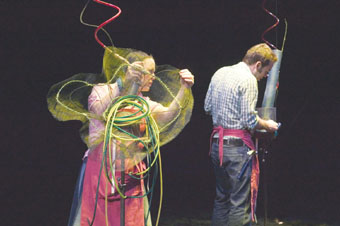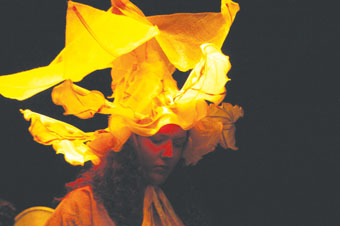Once upon the here and now
Keith Gallasch

Sacha Horler & Brendan Cowell, Far Away
photo Tania Kelley
Sacha Horler & Brendan Cowell, Far Away
Far Away begins with a familiar scenario. Harper (Gillian Jones) knits while sitting on a rocking chair beneath the stars and reassures a concerned child, Joan (Sophie Irvine/Madelaine Alexander Stedman), perhaps her niece, about something that has alarmed the girl in the night. But the child, perhaps 10 years old, so adroitly unfolds her tale that she catches Harper out. Harper’s lie is that the people the child has witnessed her uncle lock up in the night are being rescued and that those he has beaten and killed are traitors. In the end the child appears to accept her aunt’s account: “…you’re part of a big movement now to make things better. You can look at the stars and think here we are in our little bit of space, and I’m on the side of people who are putting things right and your soul will expand right into the sky.” But the residue of this lie will subconsciously shape the girl’s response to the world in which she grows up and becomes a milliner.
What in the first scene is told in the plain manner of a fable with overtones of everydayness in the horrors of Bosnia and Kosovo, becomes in subsequent scenes increasingly surreal. The girl (now played by Sacha Horler) and her fellow milliner, Todd (Brendan Cowell), speculate on the nepotism and corruption of the organisation that employs them, while never questioning the executions of the many for whom they make spectacular hats. We watch them being made with the tools of the trade, the hats are the real thing (stage milliner Rosie Boylan’s genius). We witness the execution parade as some 30 victims (all volunteers for this production) pace the stage and stare at us without expression in drab prison gear (shades of Abu Ghraib), hands bound with plastic strips, wearing magnificent creations of astonishing invention—hats in the form of orchids, fruit, animals, mimicked artworks. Not a word is spoken for some 10 minutes while the sound score (Max Lyandvert) thumps like a giant heart made anxious by the grating wail of a world at war. We gaze at the ordinary faces of the victims, each made anonymous by the glory of the hat they wear. The headware not only references millinery fantasias of earlier centuries, but also the art of the 20th, right down to Oppenheim’s fur-lined cup and saucer in visual resonance with the set (Ralph Myers), a great squared arch covered, like the floor, in thick black pile. This is a totally self-contained world, its absurdity is its reality; its milliners have no idea of their complicity.
Caryl Churchill’s fashion parade of death is a modern auto-da-fe (Portuguese for ‘act of faith’). The mass executions of heretics and non-believers, especially Jews, were staged in public spaces in Spain and Portugal from the late 15th century and held in South America and in Mexico until the mid-19th century. The victims were dressed in yellow penitential garments and wore tall, 3-pointed caps. We don’t know what crimes Churchill’s victims have committed, but we can guess at it in the play’s final scene, because the playwright’s secular auto-da-fe is embedded in a world not unlike Orwell’s 1984. Todd has come home to Harper looking for Joan because she has run away from her work, an illegal act during war. Harper is terrified that Todd’s presence and Joan’s flight will implicate her. Echoing the first scene, this one is an attempt by Harper to trap her son (if he is that, he’s certainly ‘family’) for not toeing the state line. The country is at war. With whom? Does he know? Has he got it right? In 1984 the shifting allegiances and hostilities between superstates are part of the paranoid apparatus of social control and a perpetual war economy.
However, in Far Away neurosis has turned to psychosis: the whole world, humankind and nature, is imagined to be at war. What at first seem like quirks of nature—wasps attacking horses, butterflies attacking humans—becomes as fecundly and madly inventive as the hat parade: “The cats have come in on the side of the French…”, “but it’s not as if they’re the Moroccans and the ants.” The evils of crocodiles, bears, Latvian dentists and raping, terrorist deer are agreed, but Harper has tricked Todd: “The deer are with us. They have been for 3 weeks.” Todd’s protestations of defence include having worked in an abattoir “stunning pigs and musicians.”

Far Away
photo Tania Kelley
Far Away
Joan arrives, exhausted, interior, telling the tale of her escape, passing people killed “by coffee…by pins…hairspray, bleach, foxgloves…”, her own murders of “2 cats and a child under 5”, her fear “of the weather, [it’s] on the side of the Japanese”, of the Bolivians who “are working with gravity”:
But we are getting further with noise and there’s thousands dead of light in Madagascar. Who’s going to mobilise darkness and silence?
Joan ends her tale with a simple account of the challenge of entering the river in her desperate search for safety. She has made her escape, but from what? Director Benedict Andrews has Sacha Horler gasp shortly after her final word, but in realisation of what? We’re not to know, but something has been crossed, not just a river. Churchill makes no such indication in her published playscript. But in that extremely brief text there is very little in the way of directions, everything is in spare, unaccented dialogue. In the only stage note she writes of the numbers required for the Parade: “Five is too few and twenty better than ten. A hundred?”
It is the very brevity and openness of the text that will allow for radically different interpretations and inventive stagings. Andrews keeps his distance, the emotional temperature is cool, the characters embodying the hyper-alert and the hypnotised subjects of totalitarianism. Even Todd’s protest to the management about corruption, which he knows could lose him his job, or worse, has an air of unreality about it. Gillian Jones is perfectly cast as Harper with her capacity to convey distraction and acute engagement in the same moment. Horler and Cowell together achieve the right level of naivety, Horler the instinctual shock of unutterable revelation, and the child performer in the first scene the sharp intelligence that will be crushed in the adult.
It is the finely tuned, acutely acted and directorially realised air of the impossible as real that makes Far Away an escalating nightmare of political horror. In the end, the fantastic is not the hat parade or the war with nature and things, but the acceptance of it by the people who live it out. This play, written in 2000, is working its way around the world. Here with the Sydney, Melbourne and Queensland Theatre Companies (the latter 2 in 2005 subscription seasons), it offers a rare moment when state companies engage with a potent political text.
Caryl Churchill, Far Away, director Benedict Andrews, designer Ralph Myers, costumes Tess Schofield, lighting Damien Cooper, composer Max Lyandvert, milliner Rosie Boylan; Wharf 1 Theatre, Sydney Theatre Company, opened Oct 7
RealTime issue #64 Dec-Jan 2004 pg. 45






